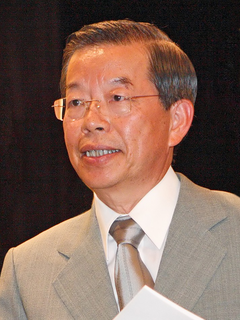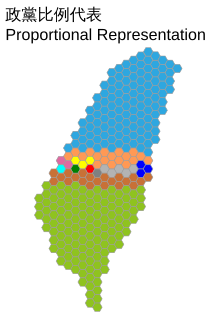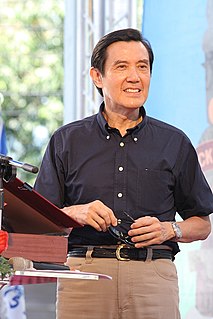Single non-transferable vote or SNTV is an electoral system used in multi-member constituency elections. It is a generalization of First-Past-The-Post, applied to multi-member constituencies.
The pan-Blue coalition, pan-Blue force or pan-Blue groups is a loose political coalition in Taiwan, consisting of the Kuomintang (KMT), the People First Party (PFP), New Party (CNP) and Non-Partisan Solidarity Union (NPSU). The name comes from the party colours of the Kuomintang. This coalition tends to favor a Chinese nationalist identity over a separate Taiwanese one and favors a softer policy and greater economic linkage with the People's Republic of China, as opposed to the Pan-Green Coalition.

The Legislative Yuan is the unicameral legislature of the Republic of China now based in Taiwan. It is one of the five branches of government stipulated by the Constitution of the Republic of China, which follows Sun Yat-sen's Three Principles of the People.
The Webster/Sainte-Laguë method, often simply Webster method or Sainte-Laguë method, is a highest quotient method for allocating seats in party-list proportional representation used in many voting systems. It is named in Europe after the French mathematician André Sainte-Laguë and in United States after statesman and senator Daniel Webster. The method is quite similar to the D'Hondt method, but uses different divisors. In most cases the largest remainder method delivers almost identical results. The D'Hondt method gives similar results too, but favors larger parties compared to the Webster/Sainte-Laguë method. Often there is an electoral threshold, that is a minimum percentage of votes required to be allocated seats.

The Election for the 6th Legislative Yuan (第六屆立法委員選舉) of Taiwan was held on December 11, 2004. All 225 seats of the Legislative Yuan were up for election: 168 elected by popular vote, 41 elected on the basis of the proportion of nationwide votes received by participating political parties, eight elected from overseas Chinese constituencies on the basis of the proportion of nationwide votes received by participating political parties, eight elected by popular vote among the aboriginal populations. Members served three-year terms beginning on February 1, 2005, and ending January 31, 2008. The next term served four years.

The Election for the 5th Legislative Yuan of Taiwan was held on 1 December 2001. All 225 seats of the Legislative Yuan were up for election: 168 elected by popular vote, 41 elected on the basis of the proportion of nationwide votes received by participating political parties, eight elected from overseas Chinese constituencies on the basis of the proportion of nationwide votes received by participating political parties, eight elected by popular vote among the Taiwanese aboriginal populations. Members served three year terms from February 1, 2002 to February 1, 2005.

An election for the National Assembly took place in Taiwan on Saturday 14 May 2005, from 07:30 to 16:00 local time. It elected an ad hoc National Assembly whose only function was to serve as a constitutional convention in order to approve or reject amendments to the Constitution of the Republic of China already proposed by the Legislative Yuan. The results indicated that the amendments would be approved, as the parties supporting them won an overwhelming majority, and indeed the amendments were passed on June 7, 2005. The election was carried out using purely the party-list proportional representation system. The official campaign period was 07:00 to 22:00 each day from 4 May 2005 to 13 May 2005. Official election broadcasts by the ad hoc coalitions and (established) parties were provided by the Public Television Service Taiwan on 7 May 2005; several unofficial debates were also arranged. Notably, this election saw the temporary breakdown of the traditional two-coalition system in Taiwanese politics: instead of dividing into the Pan-Green Coalition and Pan-Blue Coalition over the political status of Taiwan, the parties divided themselves into larger and smaller parties, with the larger Democratic Progressive Party and Kuomintang in support of the amendments and the smaller People First Party and Taiwan Solidarity Union against them.

The Kuomintang chairmanship election of 2005 was held on July 16, 2005 in Taiwan between Ma Ying-jeou and Wang Jin-pyng. The election was triggered by the retirement of chairman Lien Chan.

The Election for the 7th Legislative Yuan of Taiwan was held on January 12, 2008. The results gave the Kuomintang (KMT) and the Pan-Blue Coalition a supermajority in the legislature, handing a heavy defeat to then-President Chen Shui-bian's Democratic Progressive Party, which won the remaining 27 seats only. The junior partner in the Pan-Green Coalition, the Taiwan Solidarity Union, won no seats.
General elections were held in Taiwan, officially the Republic of China, on Saturday, 16 January 2016 to elect the 14th President and Vice President of the Republic of China, and all 113 members of the ninth Legislative Yuan:

The 9th Republic of China Legislative Yuan election was held on 16 January 2016 for all 113 seats to the Legislative Yuan in Taiwan. The Democratic Progressive Party (DPP) led by Tsai Ing-wen, who also won the presidential election on the same day, secured a majority for the first time in history by winning 68 seats. The ruling Kuomintang (KMT) lost both the presidency and its legislative majority and returned to the opposition.

Hung Tzu-yung is a Taiwanese politician. Following the death of Hung Chung-chiu, her brother, in 2013, she joined the New Power Party upon its founding in 2015, and won election to the Legislative Yuan. Hung left the NPP in August 2019, partway through her first legislative term.
Chang Sho-wen is a Taiwanese politician. He first won election to the Legislative Yuan in 2004 and was reelected in 2008. Partway through his second term, Chang was removed from office on charges of electoral fraud. He left the Kuomintang in 2015 and joined the People First Party.
Lee Yi-ting is a Taiwanese politician.

Yen Kuan-heng is a Taiwanese politician who has represented Taichung in the Legislative Yuan since 2013, when he succeeded his father Yen Ching-piao in office.
General elections will be held in Taiwan, officially the Republic of China, on 11 January 2020 to elect the 15th President and Vice President of the Republic of China, and all 113 members of the 10th Legislative Yuan.
Taipei City electoral constituencies consist of 8 single-member constituencies, each represented by a member of the Republic of China Legislative Yuan.
Taichung City electoral constituencies consist of 8 single-member constituencies, each represented by a member of the Republic of China Legislative Yuan.
Taoyuan City electoral constituencies consist of 6 single-member constituencies in Taoyuan, Taiwan, each represented by a member of the Republic of China Legislative Yuan.
The Legislative Yuan is the unicameral legislature of Taiwan, currently with 113 seats. 73 are directly elected in local single-member districts.

























